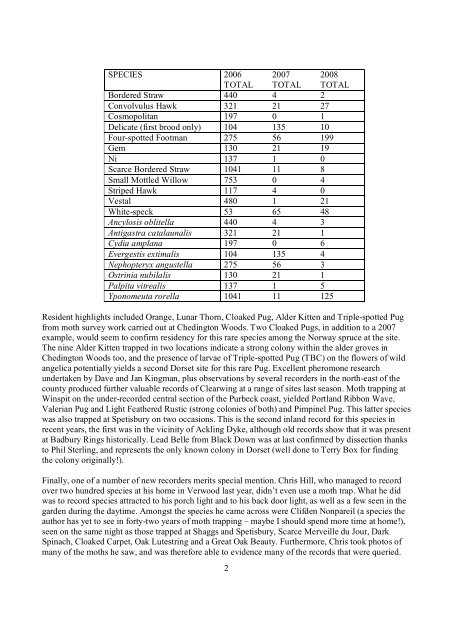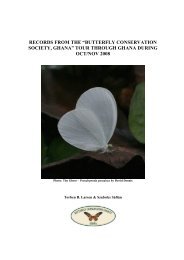newsletter 21.pdf - Dorset Moth Group
newsletter 21.pdf - Dorset Moth Group
newsletter 21.pdf - Dorset Moth Group
You also want an ePaper? Increase the reach of your titles
YUMPU automatically turns print PDFs into web optimized ePapers that Google loves.
SPECIES 2006 2007 2008<br />
TOTAL TOTAL TOTAL<br />
Bordered Straw 440 4 2<br />
Convolvulus Hawk 321 21 27<br />
Cosmopolitan 197 0 1<br />
Delicate (first brood only) 104 135 10<br />
Four-spotted Footman 275 56 199<br />
Gem 130 21 19<br />
Ni 137 1 0<br />
Scarce Bordered Straw 1041 11 8<br />
Small Mottled Willow 753 0 4<br />
Striped Hawk 117 4 0<br />
Vestal 480 1 21<br />
White-speck 53 65 48<br />
Ancylosis oblitella 440 4 3<br />
Antigastra catalaunalis 321 21 1<br />
Cydia amplana 197 0 6<br />
Evergestis extimalis 104 135 4<br />
Nephopteryx angustella 275 56 3<br />
Ostrinia nubilalis 130 21 1<br />
Palpita vitrealis 137 1 5<br />
Yponomeuta rorella 1041 11 125<br />
Resident highlights included Orange, Lunar Thorn, Cloaked Pug, Alder Kitten and Triple-spotted Pug<br />
from moth survey work carried out at Chedington Woods. Two Cloaked Pugs, in addition to a 2007<br />
example, would seem to confirm residency for this rare species among the Norway spruce at the site.<br />
The nine Alder Kitten trapped in two locations indicate a strong colony within the alder groves in<br />
Chedington Woods too, and the presence of larvae of Triple-spotted Pug (TBC) on the flowers of wild<br />
angelica potentially yields a second <strong>Dorset</strong> site for this rare Pug. Excellent pheromone research<br />
undertaken by Dave and Jan Kingman, plus observations by several recorders in the north-east of the<br />
county produced further valuable records of Clearwing at a range of sites last season. <strong>Moth</strong> trapping at<br />
Winspit on the under-recorded central section of the Purbeck coast, yielded Portland Ribbon Wave,<br />
Valerian Pug and Light Feathered Rustic (strong colonies of both) and Pimpinel Pug. This latter species<br />
was also trapped at Spetisbury on two occasions. This is the second inland record for this species in<br />
recent years, the first was in the vicinity of Ackling Dyke, although old records show that it was present<br />
at Badbury Rings historically. Lead Belle from Black Down was at last confirmed by dissection thanks<br />
to Phil Sterling, and represents the only known colony in <strong>Dorset</strong> (well done to Terry Box for finding<br />
the colony originally!).<br />
Finally, one of a number of new recorders merits special mention. Chris Hill, who managed to record<br />
over two hundred species at his home in Verwood last year, didn’t even use a moth trap. What he did<br />
was to record species attracted to his porch light and to his back door light, as well as a few seen in the<br />
garden during the daytime. Amongst the species he came across were Clifden Nonpareil (a species the<br />
author has yet to see in forty-two years of moth trapping – maybe I should spend more time at home!),<br />
seen on the same night as those trapped at Shaggs and Spetisbury, Scarce Merveille du Jour, Dark<br />
Spinach, Cloaked Carpet, Oak Lutestring and a Great Oak Beauty. Furthermore, Chris took photos of<br />
many of the moths he saw, and was therefore able to evidence many of the records that were queried.<br />
2



